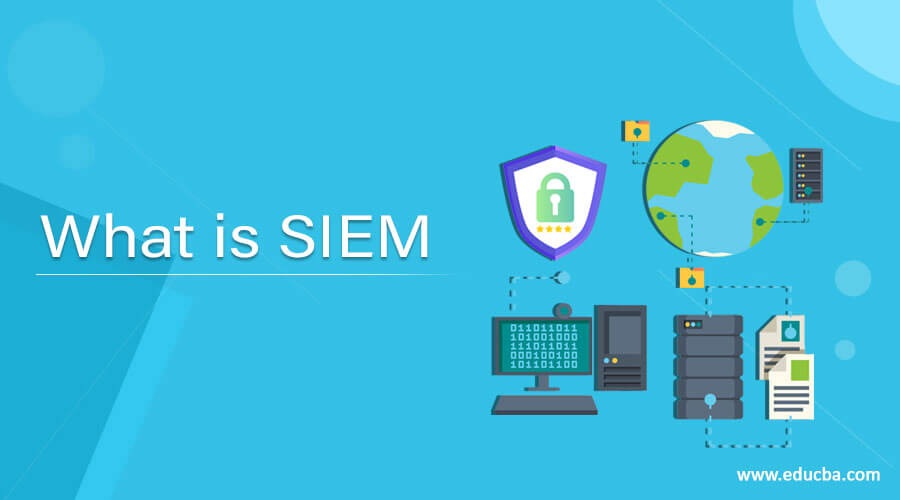Updated July 5, 2023

Introduction to SIEM
SIEM is a security management methodology integrating security information with security incident management (SIM). The SIEM acronym is declared silent. It is the software solution for aggregating and reviewing events from multiple tools in the IT infrastructure. SIEM obtains protection data from network computers, domain controllers, servers, etc. It collects, aggregates, norms, and analyses data to identify patterns and risks and helps organizations to investigate warnings. The basic concepts of each SIEM system are the compilation, identification, and effective steps of applicable data from various sources. For instance, a SIEM device can record additional information when a potential problem is detected, produce an alarm, and advise other safety checks to halt progress.
How does SIEM Work?
SIEM software gathers, and aggregates log data from host systems and apps to network and security devices created in the organization’s entire technology infrastructure, such as firewalls and anti-virus filters. The app would then classify, categorize, and interpret accidents and events. It offers two key features, for instance:
Reports on accidents and events related to security include active and missed logins, ransomware activity, and other potentially malicious practices. And submit warnings if an investigation indicates an operation that runs according to predetermined rules and shows a probable security concern. SIEM is a data aggregator, search, and reporting system at its core. SIEM captures, consolidates, and makes the knowledge available to people from the networked world.
SIEM Tools
Given below are the SIEM Tools:
1. IBMQRadar
In an organizational information system, IBM QRadar captures log data from sources, including network computers, operating systems, software, and user behaviors. QRadar can also capture data from cloud-based apps for log events and network flow. This SIEM advocates intellectual feeds for risks as well. QRadar is another standard tool deployed as a hardware, virtual system, or software appliance depending on company needs and capability. QRadar can be integrated into Varonis to add functionality for advanced threat identification.
2. ArcSight
ArcSight has an open architecture that provides it with some excellent functionality. This platform can consume data from a broader variety of sources than many SIEM products, and its organized data could be helpful for more IT teams outside ArcSight. It gathers and analyses log data from an organization’s security technology, operating systems, and applications. The device alerts security staff until a malicious attack is identified.
3. SolarWinds Threat Monitor
SolarWinds Threat Monitor is an efficient, security-driven SIEM solution that analyses security log details from multiple sources and checks for anomalies in an ongoing, global database of threats. This tool offers automatic, smart responses and detailed warnings for security incidents.
4. Sumo Logic
This tool is a modern cloud-based application for SMBs. It offers various pricing options. Since the software is recent, there is not much community-focused. Still, Sumo Logic argues that the IT protection product addresses the holes that other products skipped, in particular when it comes to cloud deployments.
5. Securonix
Securonix is a rare SIEM platform that developers and specialized security teams can use quickly. The Securonix is a functional instrument with powerful analytical and data-tracking capabilities. Securonix connects LogRhythm and IBM to manage value, deployment, ease of use, and identification with the right context for response and management. The cloud infrastructure focuses on the number of workers and provides one of the simplest payment systems for a sector with prevalent details and amounts of events.
6. Fortinet
For those who wish strong protection, particularly current Fortinet customers, the Fortinet tool is a good option. Fortinet tool has been checked more than any third party on this list. NSS Laboratories have all tested for their violation and intrusion detection, gateways, and EDR capabilities. Fortinet tool has the best score in identification, reaction, and administration.
Advantages of SIEM Tools
- It simplifies the management of protection by filtering vast quantities of security data and prioritizing security alerts created by the app.
- A SIEM system can also help a company comply with regulatory standards by automatically creating reports containing all logged security activities. The organization must capture and compile log data manually without SIEM tools.
- Business uses it for various use cases, including surveillance, auditing, compliance, support desk, and network troubleshooting, which revolve around data or logs.
Conclusion
In this article, we have seen various SIEM tools and features. These tools are easy-to-understand, intuitive, and attractive dashboards that help you centralize and develop your company without losing profound insights. You can choose any of them based on your requirements.
Recommended Articles
This is a guide to What is SIEM. Here we discuss the introduction, working of SIEM, advantages, and tools. You may also have a look at the following articles to learn more –

